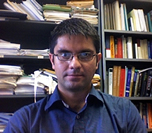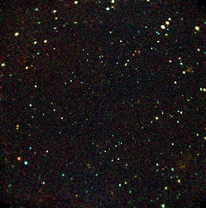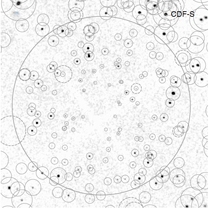The Search for Dark Matter in the Unresolved X-ray Background
By: Kevork N. Abazajian

xFigure 1 xxxxxxxxxxxxxxxxFigure 2 xxxxxxxxxxxxxxxxFigure 2 
Figure 1: False-color image of the deep exposure of the Chandra X-ray Observatory in the southern field (CDF-S).
Figure 2: The (circled) resolved point sources and extended sources that are removed from this field to determine the spectrum of the remaining unresolved X-ray background. (Note that the two panels have different orientations.)
Dark matter dominates the dynamics of the growth of cosmological large-scale structure as well as the dynamics of galaxy formation. Over seventy years from its inferred existence due to its gravitational properties by the astronomer Fritz Zwicky, the identity of the dark matter remains unknown. One clue may come from differences in the number of substructures from large scales to small scales. This has motivated the search for lighter dark matter particle candidates than previous searches, which can damp small-scale structure.
A candidate light particle that reduces small-scale structures is a neutrino-like particle that has no standard interactions, but can be produced in the early universe with its small coupling with the standard neutrinos, often described as a “sterile neutrino” (Dodelson & Widrow, 1994). The same coupling for its production requires a decay mode of the sterile neutrino into a photon and the standard neutrino with which it is coupled. The decay photon is mono-energetic and has X-ray energies. This has allowed the use of contemporary X-ray observatories such as NASA’s Chandra X-ray Observatory for a previously unintended purpose: the search for the signature of a dark matter candidate.
The Chandra X-ray Observatory was deployed by the Space Shuttle Columbia in July 1999. It is now on a highly elliptical orbit, reaching 64,000 km away from the Earth before returning to 320 km at closest approach. One mission of the observatory is to determine the source of the diffuse X-ray background, which was first detected on rocket flights in the 1960’s. Using a total of 3 megaseconds of observations, Hickox & Markevitch (2006a,b) showed that the diffuse background comes from resolved X-ray sources and galaxies resolved in the Hubble Deep Field.
The energy spectrum of the unresolved X-ray diffuse background in this observation was employed to either detect or constrain the X-ray photons in the decay of the sterile neutrino dark matter candidate (Abazajian et al., 2006). X-ray flux is expected to originate from sterile neutrino decays in the dark matter halo of the Milky Way along the line of sight of the observation. Since no line-like decay feature was seen and the decay rate increases with the particle mass, this observation places a constraint on the leading production model for the candidate sterile neutrino dark matter particle to not have a mass of more than 5.7 keV. This and other observations in the X-ray constrain much but not all of the parameter space of the sterile neutrino candidate. The lightest particle masses and couplings of this candidate remain viable, but may be probed by observations with quantum X-ray calorimeters or the proposed Constellation-X Observatory (Abazajian, Fuller, & Tucker, 2001), which would either exclude this candidate, or detect its signature decay.
References:
K. N. Abazajian, G. M. Fuller, and W. Tucker, Astrophys. J., 562, 593 (2001); astro-ph/0106002.
K. N. Abazajian, M. Markevitch, S. M. Koushiappas, and R. C. Hickox, submitted to Phys. Rev. D; astro-ph/0611144.
S. Dodelson and L. M. Widrow, Phys. Rev. Lett., 72, 17 (1994); astro-ph/9303297.
R. C. Hickox and M. Markevitch, Astrophys. J., 645, 95 (2006a); astro-ph/0512542.
R. C. Hickox and M. Markevitch, in prep., (2006b).
Dr. Abazajian is an assistant professor of Physics for the University of Maryland. He is a member of the Elementary Particle research group. Feel free to contact him at, kev@umd.edu .
|